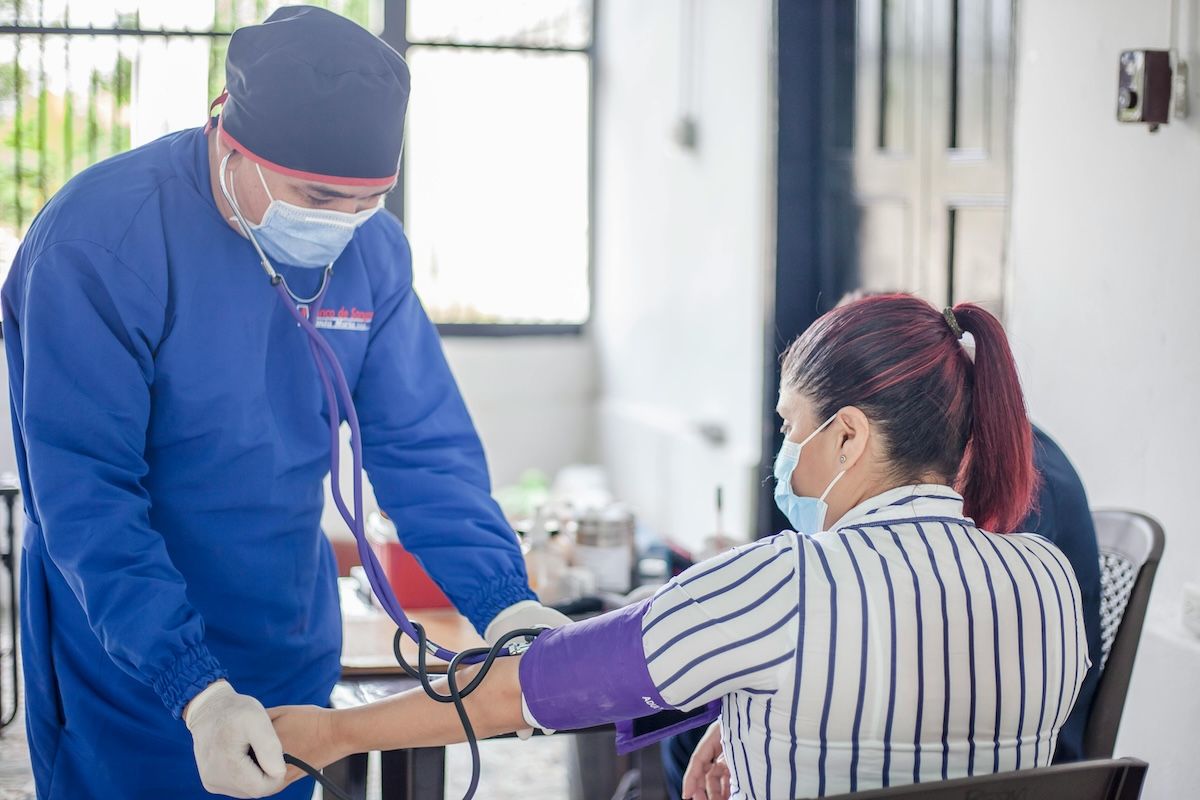Medical Assistant Job Description & Duties: What do they do for 2026?
Medical assistants play a vital role in the healthcare system, balancing both administrative and clinical responsibilities to ensure smooth operations in medical offices, hospitals, and clinics. However, many aspiring professionals struggle to understand the full scope of a medical assistant’s job, the required qualifications, and the career potential in this fast-growing field. Without clear guidance, it can be overwhelming to decide whether this career is the right fit.
This guide will break down the key job duties, required skills, certification options, work environments, and career growth opportunities for medical assistants. Whether you are considering a career as a medical assistant, currently enrolled in a training program, or looking to advance in the field, this resource will provide expert insights and answers to common questions.
Key things you should know about medical assistant job description and duties:
- Medical assistants can work in various healthcare settings, such as hospitals, private practices, urgent care centers, and specialty clinics.
- Certification is not always required but highly recommended, as credentials like CMA or RMA improve job prospects and earning potential.
- The average salary for medical assistants in the U.S. is around $42,000 per year.
Table of Contents
- What does a medical assistant do on a daily basis?
- How much is the average salary for medical assistants for 2026?
- How does a medical assistant's role differ from that of a nurse or physician assistant?
- What are the key skills required to become a successful medical assistant?
- What clinical procedures can medical assistants legally perform?
- Which states pay medical assistants the highest salaries?
- What education is required to become a medical assistant?
- How can I manage the costs of medical assistant training and certification?
- How is technology enhancing the role of medical assistants?
- Do medical assistants need certification, and which ones are most recognized?
- How long does it take to become a medical assistant?
- What common challenges do medical assistants encounter?
- What specialized certifications can further elevate your career as a medical assistant?
- Should medical assistants consider pursuing advanced public health degrees?
- How can additional academic credentials elevate a medical assistant’s career?
- What healthcare settings or industries hire medical assistants?
- What is the job outlook for medical assistants over the next decade?
- How can medical assistants advance to higher healthcare roles?
- Other things you should know about medical assistant duties
What does a medical assistant do on a daily basis?
A medical assistant's daily responsibilities vary depending on the healthcare setting but typically include a mix of administrative and clinical tasks to support doctors and nurses. Here are some of the daily tasks of a medical assistant:
- Administrative Tasks – Medical assistants manage front-office duties like scheduling appointments, updating patient records, processing insurance claims, and answering phone calls to keep the office running smoothly. They also handle billing, coding, and correspondence to ensure accurate documentation and efficient patient flow.
- Patient Care & Interaction – They greet patients, collect medical histories, and explain procedures to help ease patient anxiety. Medical assistants also provide post-visit instructions, ensuring patients understand medication guidelines and follow-up care.
- Clinical Duties – Medical assistants take vital signs, prepare patients for examinations, and assist doctors with minor procedures. They may also administer injections, draw blood, and perform basic lab tests as part of patient care, similar to how students in ultrasound tech programs online learn essential diagnostic imaging skills to support healthcare teams.
- Medical Equipment & Supplies Management – Ensuring exam rooms are stocked with essential medical supplies and that equipment is properly sterilized is a crucial part of the job. This helps maintain a safe, efficient, and well-organized healthcare environment.
- Collaboration with Healthcare Teams – Medical assistants work closely with doctors, nurses, and lab technicians to ensure seamless patient care. Their role bridges the gap between administrative tasks and clinical support, making them essential members of any healthcare team.
How much is the average salary for medical assistants for 2026?
According to 2025 data from job board Indeed, medical assistants in the US earned an average base salary of $47,116. Salaries can vary widely based on factors such as geographic location, experience level, and the type of healthcare facility. The lowest 10% of medical assistants earn less than $33,500 annually, while the highest 10% make over $56,480 per year. Medical assistants working in hospitals and specialty clinics often earn higher wages compared to those in physician’s offices or outpatient care centers.
Several factors influence the medical assistant salary potential, including certifications, additional skills, and years of experience. Certified Medical Assistants (CMAs) and Registered Medical Assistants (RMAs) generally earn more than those without certification. Additionally, states with higher costs of living or greater demand for healthcare professionals tend to offer higher wages. As demand for medical assistants continues to grow, salaries are expected to remain competitive, making this a stable and rewarding career choice.
How does a medical assistant's role differ from that of a nurse or physician assistant?
Medical assistants, nurses, and physician assistants (PAs) all play essential roles in patient care, but their education, responsibilities, and levels of authority differ significantly. Here are some ways in which they differ:
- Level of Training & Education – Medical assistants typically complete a one-year certificate or a two-year associate degree program, while nurses (LPNs and RNs) require more extensive education, and physician assistants (PAs) must complete a master’s degree and pass a licensing exam. Some nurses looking to advance their careers pursue accelerated programs, such as an RN to BSN in 6 months, to expand their job opportunities in the healthcare field.
- Scope of Practice – Medical assistants handle both administrative and clinical tasks, such as scheduling appointments and taking vital signs, while nurses focus more on direct patient care, including administering medications and assisting with treatments. PAs, on the other hand, diagnose illnesses, prescribe medications, and develop treatment plans under a physician’s supervision.
- Work Environment & Responsibilities – Medical assistants typically work in outpatient settings, such as clinics and physician’s offices, while nurses and physician assistants often work in hospitals, emergency rooms, and specialized medical facilities with more direct patient interaction.
- Medical Decision-Making – Unlike nurses and physician assistants, medical assistants cannot diagnose conditions or create treatment plans. Nurses provide clinical care based on a doctor’s orders, while PAs have more autonomy and can make independent medical decisions in many states.
- Licensing & Certification Requirements – Medical assistants can work without certification in some states, though credentials like CMA or RMA improve job prospects. Nurses must be licensed (LPN or RN) through state nursing boards, and physician assistants must pass the PANCE exam and meet strict certification and continuing education requirements.
For medical assistants aspiring to become nurses, one clear path is to enroll in a 12 month RN program online. These programs are specifically designed for individuals with prior healthcare experience and can provide an accelerated route to becoming a registered nurse, helping to bridge the gap between medical assisting and nursing roles.
In terms of nursing education, it’s important to understand the differences in requirements for ADN AAD and AAS degrees. These programs vary in their focus and length, with ADN (Associate Degree in Nursing) typically being the most common route to becoming a registered nurse, while AAS (Associate of Applied Science) and AAD (Associate of Arts in Developmental Studies) may have different focuses or prerequisites depending on the institution.
What are the key skills required to become a successful medical assistant?
To excel as a medical assistant, professionals must possess a diverse set of clinical, administrative, and interpersonal skills to effectively support healthcare teams and provide quality patient care. Below are the key skills required to become a successful medical assistant:
- Clinical Skills – Medical assistants must be proficient in taking vital signs, administering injections, drawing blood, and assisting with medical procedures to support physicians and nurses in patient care.
- Administrative Competence – Strong organizational and computer skills are essential for managing patient records, scheduling appointments, handling insurance billing, and ensuring smooth office operations.
- Communication & Interpersonal Skills – Medical assistants interact with patients, doctors, and healthcare staff daily, requiring clear communication, active listening, and a compassionate approach to patient care.
- Attention to Detail – Accuracy is crucial when recording patient information, handling medications, and performing clinical tasks to prevent errors and ensure patient safety.
- Multitasking & Time Management – The fast-paced nature of medical offices and clinics requires medical assistants to efficiently balance multiple responsibilities, from assisting with procedures to managing administrative duties.
The skills developed as a medical assistant are highly transferable to other healthcare professions, should you choose to advance your career. For example, if you decide to become a nurse or a respiratory therapist, you will find that many of the competencies, such as patient care, attention to detail, and communication, are valuable in those roles as well. In fact, a common consideration for those making this transition is the choice between an RN vs RT degree program. While both paths are essential in healthcare, they differ in focus: an RN program prepares you for broad patient care, while an RT program specializes in respiratory care, requiring different skills and training.
What clinical procedures can medical assistants legally perform?
Medical assistants play a crucial role in supporting physicians and nurses by performing a variety of clinical procedures, but their scope of practice is determined by state regulations and employer guidelines. While they are not licensed medical professionals like nurses or physician assistants, they can perform certain hands-on tasks under a doctor's supervision. Below are some of the clinical procedures that medical assistants can legally perform in most states:
- Taking Vital Signs – Medical assistants regularly check and record patient vital signs, including blood pressure, heart rate, temperature, and respiratory rate, to assist doctors in monitoring patient health.
- Administering Injections & Medications – In many states, medical assistants can give intramuscular, subcutaneous, or intradermal injections, as well as administer medications under physician supervision.
- Drawing Blood & Collecting Lab Samples – Medical assistants often perform phlebotomy procedures, such as drawing blood and collecting urine or throat swab samples for laboratory testing.
- Performing Basic Wound Care – They may clean and dress wounds, remove sutures or staples, and assist in minor surgical procedures, depending on state regulations.
- Assisting with Examinations & Procedures – Medical assistants prepare patients for exams, set up medical equipment, and assist doctors during procedures such as electrocardiograms (EKGs), spirometry tests, or vision screenings. Similar to 1-year radiology tech programs, which train students for hands-on roles in diagnostic imaging, medical assistant programs provide essential clinical skills to support healthcare professionals in various medical settings.
Which states pay medical assistants the highest salaries?
Medical assistant salaries vary significantly across the United States, with certain states offering higher compensation due to factors like cost of living and demand for healthcare services. Washington is the highest-paying state for medical assistants, with a median annual salary of $52,600. Alaska follows closely, offering medical assistants a median salary of $50,160, reflecting the state’s higher cost of living and need for healthcare workers in remote areas.
Other high-paying states include California, where medical assistants earn a median annual salary of $46,690, and Massachusetts, which offers a median salary of $47,770. Minnesota also ranks among the top states, with medical assistants earning a median salary of $48,890. These salaries are well above the national median of $42,000, making these states attractive for medical assistants seeking higher wages. The chart below shows the top 5 states with the highest average salary for medical assistants:
What education is required to become a medical assistant?
Here are the educational requirements that you need to become a medical assistant:
- High School Diploma or GED – A high school diploma or equivalent is the minimum educational requirement to enter a medical assistant training program or receive on-the-job training.
- Certificate or Diploma Program – Many medical assistants complete a certificate or diploma program from an accredited school, typically lasting 9 to 12 months, covering clinical and administrative skills.
- Associate Degree in Medical Assisting – Some students choose a two-year associate degree in medical assisting, which provides a more in-depth education and can lead to better job opportunities.
- Certification Options – While not always required, earning a credential like Certified Medical Assistant (CMA) or Registered Medical Assistant (RMA) can enhance job prospects and salary potential.
- On-the-Job Training – In some cases, medical assistants can be trained directly in a healthcare setting, but most employers prefer candidates with formal education and certification. Similarly, professionals looking to advance in the medical field, such as paramedics transitioning to nursing, often pursue a paramedic to RN bridge program online to gain the necessary credentials and expand their career opportunities.
While some medical assistants receive on-the-job training, most complete a certificate, diploma, or associate degree program in medical assisting to gain the necessary knowledge and skills. These programs, which typically take nine months to two years, cover subjects such as medical terminology, anatomy, pharmacology, and clinical procedures, along with administrative training in medical billing, scheduling, and record-keeping.
How can I manage the costs of medical assistant training and certification?
Prospective medical assistants should carefully analyze tuition fees, materials costs, and certification expenses to ensure a sustainable investment in their education. Evaluating accredited programs that offer flexible payment options, scholarships, and bundle deals for both administrative and clinical training can help manage expenses efficiently. Some programs integrate billing and coding modules, enabling candidates to expand their skill set and potentially enhance their earning potential. Individuals looking to compare overall educational investments may also find value in reviewing details such as medical coding certification cost to make an informed decision.
Medical assistant programs are generally more affordable than many other healthcare-related education options. For example, radiographer vs radiologist degree programs requirements can differ significantly, with radiologist programs generally requiring more extensive education and training, leading to higher costs compared to radiography programs.
How is technology enhancing the role of medical assistants?
In today’s dynamic healthcare environment, technological advancements such as electronic health records, telemedicine, and digital scheduling platforms are transforming the way medical assistants manage both clinical and administrative tasks. These digital tools not only streamline workflows but also improve patient care by enabling faster data retrieval and more accurate record keeping. Medical assistants are now expected to develop strong digital competencies, including effective data management, cybersecurity awareness, and the ability to operate cutting-edge healthcare software. For professionals looking to enhance their technical skills while remaining cost-conscious, exploring programs offered by accredited online medical assisting programs can be a strategic move for career advancement.
Do medical assistants need certification, and which ones are most recognized?
While certification is not legally required to work as a medical assistant in most states, many employers prefer or require certified candidates. Earning a certification demonstrates competency, professionalism, and a commitment to quality patient care, often leading to higher salaries and better job opportunities. Below are the most recognized certifications for medical assistants:
- Certified Medical Assistant (CMA) – Offered by the American Association of Medical Assistants (AAMA), the CMA credential is one of the most widely recognized and requires completion of an accredited program and passing an exam.
- Registered Medical Assistant (RMA) – Issued by the American Medical Technologists (AMT), the RMA certification is another well-respected credential, requiring education, experience, or military training to qualify.
- National Certified Medical Assistant (NCMA) – Provided by the National Center for Competency Testing (NCCT), this certification requires candidates to complete formal education or relevant work experience and pass an exam.
- Certified Clinical Medical Assistant (CCMA) – The National Healthcareer Association (NHA) offers the CCMA credential, which focuses on clinical duties such as patient care, phlebotomy, and EKG testing.
- Certified Medical Administrative Assistant (CMAA) – Also offered by the NHA, this certification is designed for medical assistants specializing in administrative tasks like scheduling, billing, and medical office management.
How long does it take to become a medical assistant?
Training duration varies based on educational track and program structure. Traditional programs usually require nine months to two years, while intensive, accelerated courses offer a condensed curriculum designed to prepare candidates quickly. These accelerated options focus on essential clinical and administrative skills, ensuring graduates are job-ready in a shorter timeframe. For a detailed overview of accelerated pathways and time-efficient training options, review How long does it take to become a medical assistant?.
What common challenges do medical assistants encounter?
Medical assistants face challenges that demand continuous adaptation and resilience. Balancing clinical procedures with administrative duties in fast-paced environments often leads to high-pressure situations that require efficient time management and prioritization. In addition, fluctuating regulatory requirements and technological advancements call for ongoing professional development to maintain compliance and operational efficiency. Variations in role definitions among different healthcare settings can also create uncertainties in responsibilities and compensation. For those considering alternative career pathways or seeking clearer financial prospects, exploring opportunities in healthcare administration jobs salary may provide a strategic advantage.
What specialized certifications can further elevate your career as a medical assistant?
Medical assistants looking to diversify their skill set and open doors to specialized roles may consider pursuing targeted certifications. These credentials, distinct from core clinical training, can validate proficiency in areas such as phlebotomy, EKG operation, and medical imaging. For instance, professionals interested in diagnostic procedures can explore certification programs in sonography. Investigating training opportunities from the best ultrasound tech schools may provide access to comprehensive curricula and clinical practicums that enhance both technical acumen and career flexibility. Recognizing and obtaining niche certifications can be a strategic move to meet evolving industry demands while improving professional credibility and long-term advancement prospects.
Should medical assistants consider pursuing advanced public health degrees?
For those aiming to assume broader leadership or public health roles, an advanced degree offers a clear strategic advantage. Pursuing a master’s in public health equips professionals with in-depth knowledge in health policy, epidemiology, and program management, expanding their capability to impact healthcare at an administrative level. This advanced training enhances skills in data analysis and strategic planning that are critical in navigating complex health systems and guiding community health initiatives. Individuals considering long-term career growth should evaluate cost-effective programs such as the cheapest masters in public health online to secure a competitive edge in an evolving industry.
How can additional academic credentials elevate a medical assistant’s career?
Pursuing supplementary academic qualifications can complement hands-on experience and specialized certifications, broadening a medical assistant’s scope beyond routine clinical tasks. Enhanced academic credentials foster a deeper understanding of biological sciences and healthcare dynamics, which can be advantageous when transitioning to supervisory or specialized roles. For example, programs that blend accelerated science training with healthcare management can build a robust foundation in critical biological principles. Exploring options such as the fastest online biology degree can provide insights that support strategic decision-making and long-term career growth.
What healthcare settings or industries hire medical assistants?
Medical assistants are integral to various healthcare settings, performing both clinical and administrative tasks to support patient care. According to the U.S. Bureau of Labor Statistics (BLS), the primary industries employing medical assistants include:
- Outpatient Care Centers: These facilities, support patient care by conducting routine tests, managing records, and facilitating communication between patients and providers. The average salary for medical assistants working in this industry is around $46,090
- Hospitals (State, Local, and Private): Within hospitals, medical assistants perform tasks such as drawing blood, preparing patients for procedures, and coordinating with medical staff. The average salary for medical assistants working in this industry is around $44,350.
- Offices of Physicians: Medical assistants in these settings handle patient histories, assist with examinations, and manage administrative duties. The average salary for medical assistants working in this industry is around $40,670.
- Offices of Other Health Practitioners: This includes working with chiropractors, podiatrists, and other specialists, where medical assistants assist in patient preparation and administrative tasks. The average salary for medical assistants working in this industry is around $36,480.
- Ambulatory Healthcare Services: Medical assistants in these services often perform a mix of clinical and administrative roles, ensuring the efficient operation of healthcare services. In specialized fields like nephrology, they may work alongside a dialysis technician, assisting with patient care and maintaining medical records for those undergoing treatment for kidney disease.
These figures indicate that medical assistants in outpatient care centers tend to earn higher median wages compared to those in other settings. It is still important to note that salaries can vary based on factors such as geographic location, experience, and specific employer practices. The chart below shows the average salaries of medical assistants in different industries:
What is the job outlook for medical assistants over the next decade?
The job outlook for medical assistants over the next decade is highly favorable. According to the U.S. Bureau of Labor Statistics (BLS), employment of medical assistants is projected to grow 15 percent from 2023 to 2033, much faster than the average for all occupations. This growth is expected to result in approximately 119,800 job openings each year, on average, over the decade.
Many of these openings will arise from the need to replace workers who transfer to different occupations or exit the labor force, such as to retire. The increasing demand for healthcare services, driven by an aging population and expanded access to healthcare, contributes to the positive employment outlook for medical assistants.

Here’s what graduates have to say about their medical assisting degrees:
Becoming a medical assistant with a background in psychology has been incredibly rewarding. Understanding patient behavior and mental health has helped me provide compassionate care and support to those dealing with anxiety or stress in medical settings. Every day, I see how my skills make a real difference in patients' comfort and well-being. – Hailey
My psychology studies gave me a strong foundation in communication and empathy, which are essential as a medical assistant. I work closely with patients who may be nervous or in pain, and my ability to reassure and support them has made my job even more fulfilling. Seeing patients leave with a sense of relief makes every day worthwhile. – Alex
I never expected my psychology background to be so useful in medical assisting, but it has helped me connect with patients on a deeper level. From recognizing signs of emotional distress to working with doctors on patient-centered care, I feel like I’m truly making an impact. This career path has given me stability, purpose, and personal growth. – Claire
How can medical assistants advance to higher healthcare roles?
Medical assistants have the opportunity to expand their career potential through advanced education and specialized certifications that open doors to leadership and clinical specialization. Further academic pursuits can facilitate transitions into healthcare administration or roles with a stronger focus on patient management and medication oversight. In some cases, professionals consider complementary advanced degrees—such as those explored in online Pharm D programs—to deepen their expertise and broaden their responsibilities. These progressive steps not only enhance clinical proficiency but also empower individuals to contribute strategically to evolving healthcare processes.
Key Findings
- Medical assistants perform both patient care tasks and office duties, making them a crucial part of healthcare teams.
- Employment of medical assistants is projected to grow 15% from 2023 to 2033, much faster than the average for all occupations.
- Medical assistants work in physicians’ offices, hospitals, outpatient care centers, and other healthcare facilities.
- The median annual salary for medical assistants varies by industry, with outpatient care centers offering the highest pay at $42,000.
- While not always required, certifications like CMA, RMA, and CCMA improve job prospects and salary potential.
Other things you should know about medical assistant duties
What is the most important role of a medical assistant?
The most important role of a medical assistant is to support healthcare providers by ensuring smooth clinical and administrative operations, ultimately improving patient care. They serve as a vital link between doctors, nurses, and patients by taking medical histories, assisting with examinations, administering basic procedures, and managing medical records. Their ability to handle both clinical duties, such as drawing blood and measuring vital signs, and administrative tasks, like scheduling appointments and processing insurance paperwork, helps medical facilities run efficiently. By balancing these responsibilities with strong communication and empathy, medical assistants play a crucial role in enhancing the overall patient experience and quality of care.
Are online medical assistant programs accredited and accepted by employers?
Yes, many online medical assistant programs are accredited and accepted by employers, but it is essential to choose a program accredited by recognized organizations such as the Commission on Accreditation of Allied Health Education Programs (CAAHEP) or the Accrediting Bureau of Health Education Schools (ABHES). Accreditation ensures that the program meets industry standards and prepares students with the necessary clinical and administrative skills. Most employers prefer candidates who have completed an accredited program and obtained certification, such as a Certified Medical Assistant (CMA) or Registered Medical Assistant (RMA). Before enrolling, students should verify the program’s accreditation status and check if it includes hands-on clinical training, as some states and employers require in-person experience.
Can a medical assistant draw blood or give injections?
Yes, medical assistants can draw blood and give injections, but their scope of practice depends on state regulations and employer policies. In most states, medical assistants who have received proper training can perform venipuncture (drawing blood) and administer injections, including vaccines and medications, under the supervision of a licensed healthcare provider. Some states may require additional certification, such as a phlebotomy certification, for medical assistants to perform blood draws. It is important for medical assistants to understand their state’s guidelines and receive the necessary training and supervision to ensure patient safety and compliance with healthcare regulations.
Do medical assistants receive benefits like health insurance and retirement plans?
Yes, many medical assistants receive benefits like health insurance and retirement plans, but the availability and extent of benefits depend on the employer, workplace setting, and employment status (full-time vs. part-time). Full-time medical assistants working in hospitals, physician’s offices, and outpatient care centers often receive comprehensive benefits packages, including medical, dental, and vision insurance, paid time off, and retirement plans like a 401(k). Some employers also offer tuition reimbursement, professional development opportunities, and certification fee coverage to encourage career growth. However, part-time or contract medical assistants may have limited or no benefits, making it important to review job offers carefully before accepting a position.
Resources:
- All Allied Health Schools. (2025). How Much Do Medical Assistants Make? (2025 Salary by State). https://www.allalliedhealthschools.com
- Indeed. (n.d.). Medical assistant salary in United States. Indeed.
- U.S. Bureau of Labor Statistics. (2024). Occupational Outlook Handbook: Medical Assistants. https://www.bls.gov


































